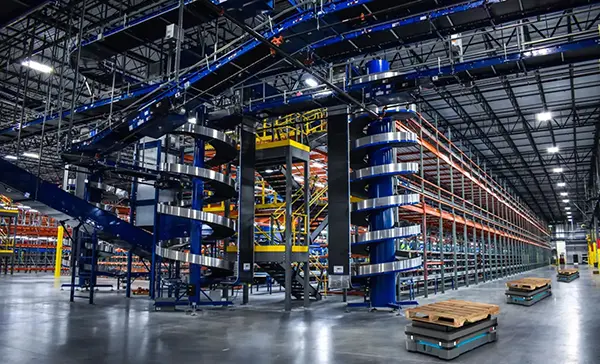Forget the quiet, dusty aisles of old-school storage. Step onto the floor of a next-generation automated warehouse, and you’re hit with a symphony of controlled chaos. It’s a ballet performed by hundreds of orange discs—Autonomous Mobile Robots (AMRs)—zipping silently across the concrete, lifting entire shelves and delivering them to waiting stations. Overhead, a conveyor system hums, whisking packages through a gauntlet of scanners before they’re gently nudged down the correct chute by automated arms. This isn’t science fiction; it’s modern intralogistics, a high-stakes game of real-time Tetras where the speed of a single package is a direct result of millions of flawless data transactions.

But beneath this mesmerizing dance of machinery lies a hidden, and often overlooked, nervous system: the labyrinth of cabling for intralogistics. This complex web of data and power cables is the true unsung hero, the silent conductor ensuring every robot, scanner, and sorter plays its part in perfect harmony. If one data stream stutters, the entire symphony grinds to a halt.
The Digital Central Nervous System
At the heart of the operation is the Warehouse Management System (WMS), the facility’s all-knowing brain. But a brain is useless without nerves to carry its commands. Every instruction—every directive telling an AMR where to go, every signal illuminating a pick-to-light system, every command to a sorting arm—travels at light speed through a robust network of ethernet cables.
This isn’t your average office internet setup. The demand here is relentless. We’re talking about real-time, mission-critical data transfer with zero tolerance for latency or failure. The cables must handle massive data loads from thousands of connected devices simultaneously, all while being resistant to the electrical “noise” generated by powerful motors and drives. It’s a digital superhighway where a single glitch can cause a traffic jam of epic proportions, turning a symphony into a cacophony of stalled robots and delayed orders.
Powering The Pulse: Energy on The Move
While data is the command, power is the lifeblood. The most fascinating challenge in a dynamic environment isn’t powering stationary equipment; it’s delivering continuous energy to the constantly moving performers—the AMRs. How do you keep a robot powered when it’s in motion 24/7?
Many systems utilize smart charging stations where robots can autonomously dock for a quick, opportunistic sip of energy between tasks. The power infrastructure to these stations must be incredibly resilient. But the real magic happens in the flexible cabling attached to moving machinery itself, like on the robotic shuttles that run on fixed tracks within storage racks. These cables are in a perpetual state of flexing, twisting, and rolling. A standard cable would fatigue, crack, and fail in a matter of weeks under such constant stress. The cabling for these applications is a marvel of engineering, designed for millions of cycles of continuous motion, ensuring the power pulse never skips a beat.
The Hostile Environment: More Than Just Dust Bunnies
A warehouse floor is a brutal environment for delicate electronics and wiring. It’s a world far removed from the safe, air-conditioned confines of a server room. The invisible threats are numerous:
Continuous Abrasion: Cables routed across floors or in cable carriers are relentlessly rubbed against surfaces and each other. Without superior exterior jacketing, the inner conductors are quickly exposed, leading to short circuits and data corruption.
Crushing Forces: It’s not uncommon for heavy-duty forklifts or other mobile robots to accidentally drive over a cable. A cable that can’t withstand immense crushing forces becomes a frequent point of failure, leading to costly downtime and repairs.
Chemical Intrusion: Spills happen. From cleaning agents and oils to hydraulic fluids, cables need to be protected against a range of chemicals that can degrade standard insulation materials, causing them to become brittle and crack.
Temperature Extremes: Especially in colder climates, unheated warehouses can become freezing, making standard plastics and coatings brittle and prone to damage from even minor impacts.
This is why the industry relies on purpose-built solutions designed specifically for these trials. Think of it as the difference between wearing dress shoes and steel-toed work boots on a construction site. The right cabling is the ruggedized PPE for your data and power, built from materials like specially formulated thermoplastic elastomers (TPE) that remain flexible across a wide temperature range and are resistant to oils and chemicals.
Simplifying The Spine: The Push For Integration
With thousands of connections to make, complexity is the enemy of efficiency and reliability. The more time technicians spend on intricate, error-prone terminations, the higher the risk of a mistake that can take a system offline. This has driven a major trend towards pre-engineered, connectorized systems.
Imagine receiving a cable that’s already fitted with a robust, sealed connector on each end, specifically designed to click perfectly into a motor, sensor, or control cabinet. This plug-and-play approach drastically reduces installation time, minimizes human error, and ensures every connection is secure, reliable, and protected from the environment from day one. It’s about building a spine that’s not only strong but also simple to assemble and maintain.
The Unsung Hero of Efficiency
We like speedy deliveries; whether we are buying irresistible gym shoes or the tank for a terrarium project, our psyche loves efficient and quick turnarounds. In the end, the goal of all this technology is breathtaking operational efficiency—the ability to fulfill an order with pinpoint accuracy in a matter of minutes. Every second saved in the journey of a package can be traced back to the flawless execution of commands sent through a wire and the unwavering power delivered through a conductor.
The next time you receive a package with astonishing speed, remember the incredible automation that made it possible. And then, remember the silent, resilient, and brilliantly engineered network of cables that made that automation work. In the high-stakes world of intralogistics, the most intelligent robot in the world is only as good as the cable that connects it to its mission. It’s the hidden infrastructure that truly keeps the modern world turning, one package at a time.










